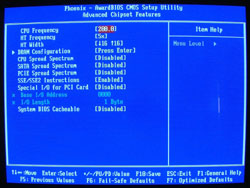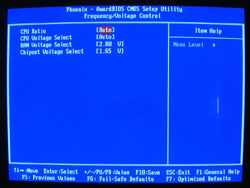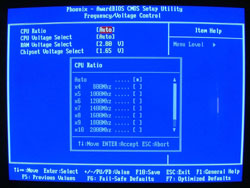BIOS and Software Setup
Note: Shuttle sent us several updated BIOS versions. The first enabled 1T command rates, but then the timings were locked at 2-3-3-5 (regardless of what you specified in the BIOS). They sent us an updated version, FN25S904.BIN, which allowed proper adjustment of the memory timings. 1T command rates have improved scores noticeably in the past, so we would recommend that anyone interested in the SN25P should make sure to get the latest BIOS from Shuttle. At present, they are up to BIOS revision FN25S906, which improves overclocking stability, but we only received that after this article was written.With the components all installed, the system is now ready to be powered up. We start by checking out the BIOS screens and features. The standard and advanced BIOS screens are pretty standard for a Phoenix/Award BIOS. Moving on to the advanced chipset features, we start to encounter some of the more interesting options.
 |
 |
| Click on images to enlarge. | |
Here, we find the controls for the CPU bus speed as well as the HyperTransport bus. A submenu contains the DRAM Timings, which are sometimes necessary in order to tune your system for optimal performance. In our system, the RAM (Samsung TCCD 2-2-2-5) was not detected properly and defaulted to 2.5-4-2-8 timings. We set it to 2-2-2-7 before continuing. (Wes' memory tests have shown a tRAS of 7 to produce the highest performance on nForce4 chipsets.)
 |
 |
| Click on images to enlarge. | |
The Frequency/Voltage screen will also be of interest to enthusiasts. The CPU bus speed can be set from 200 to 250, although even with the tested BIOS revision, we were unable to make use of most of the available settings. Serious overclockers would like the ability to run the bus at least to 300 MHz. However, before such a feature becomes meaningful, we'll need to be able to actually reach the high bus speeds. Shuttle has informed us that they are working on an updated BIOS that will allow for higher bus speeds, hopefully up to 300 MHz, but our tested version had difficulties as you'll see in our overclocking results.
We have included pictures of the remaining BIOS screens just to be complete, and those interested in seeing the other options should download the full image set.
After the BIOS is set up the way that we like it, we move on to installing Windows XP. There isn't much to talk about until the OS installation is finished - at which point, we need to install the chipset and audio drivers. Shuttle includes a CD for this purpose, along with utilities like WinFlash and Adobe Acrobat Reader 6. A second CD includes a copy of Trend Micro PC-cillin 2004 Internet Security - an anti-virus and firewall program - along with Muvee autoProducer 3.1 CE, a video editing package. We didn't really pay much attention to the Muvee product, but Trend Micro is a well-known anti-virus firm, and a free copy of their software is a decent extra. It is a full year subscription, which is even better, as opposed to a 30 or 90 day trial version.
Worth noting is that the audio drivers by default do not run in hardware accelerated mode. In order to activate this, open the VIA Envy control panel, click the "Advanced" tab, and check the box for "Sound Effects/3D Gaming Support". It will be necessary to reboot the system for this to take affect. If you fail to do this, sound in several games loses some of the advanced 3D effects. 3DMark03/05 will also disable the audio acceleration tests and report the hardware as being capable of supporting 0 hardware accelerated 3D streams. Once you've enabled the feature, you will get the proper sound support, and the drivers will report the ability to accelerate 64 3D audio streams.
That takes care of the system setup. After installing our standard benchmarking software, we're ready to see how the system actually performs in day-to-day use.










30 Comments
View All Comments
Iargonaut - Wednesday, May 4, 2005 - link
One question - not concerning image quality (there are several other reviews on the net with worse pictures!) - how about the stability and the speed of the ethernet port? I read on sfftech.com that there have been some issues with this.And finally when and what is the next nforce 4 SFF to be expected?
Thanks and as always: great review!
JarredWalton - Saturday, July 30, 2005 - link
Soon... very soon! Including some updated SN25P benchmarks (Network as well as overclocking).JarredWalton - Friday, March 11, 2005 - link
I understand that GIF/PNG would have been smaller. Again, I have deleted the originals, and the Shuttle provided image was already in JPG format. If I were to convert them to GIF/PNG now, the JPEG artifacts make it pointless. The system is disassembled, so I can't just recreate the images at the drop of a hat.As far as bandwidth and page loads are concerned, bandwidth is practically free for servers. It's not a major concern. I mean, I contributed to a reduction in bandwidth by creating thumbnails that are 1/9 the size of the larger images, mostly because I don't think a lot of people are really that concerned about looking at *every* image in high detail.
Personally, I'm more upset about the lousy quality of some of my pictures (not a very good camera) than I am with the size of the CPUZ images. I'm still trying to figure out the best way to get clean images. I'll be trying some brighter lights for the next set of pictures, so we'll see if that helps.
FWIW, even if the entire content of one of our pages was 60KB - which would stream in about 1 second over any broadband connection - it would take anywhere from 2 to 4 seconds to render the pages due to their complexity. Pentium 3 and low end Athlon systems are substantially slower at page rendering. Also, what about the non-AnandTech ad servers? Sometimes those are a bigger bottleneck than anything else. Anyway, I'm not involved AT ALL in the site design, so the only thing I have sway over is what sits in the middle of the pages. :)
cosmotic - Friday, March 11, 2005 - link
You could cut the filesize of the header on each page down by half if you just stuck it in fireworks, clicked gif, then exact palette. You could go a little further by using an 8bit PNG, and also lose pattent issues. If you touched it up a little bit, you could make it 1/4 the originial size.cosmotic - Friday, March 11, 2005 - link
As Ed points out, it saves on bandwidth. If you cut the page sizes in half by optimizing images and such, you would save a ton on bandwidth. Plus, even on broadband, page loads are not instant. If you could get it under 40K, then it would load in 1 second (still not instant). but at 170K, it would take 3 more seconds for people with average broadband connections. When people get fiber in their homes, are you going to start using TIFFs? Not only are you waisting your bandwidth, and the bandwidth of your visiters, your also contributing to clogging up large pipes cross-country. It's not a huge deal, but if every one took your aditude, the internet would be slllooooowwww. Why is it so hard to compress the images? Just stick them in Fireworks or whatever and spend 20 seconds makeing them smaller. If you spend 5 min making all the cross-site images half as small, you would save a bundle on bandwidth.GoatHerderEd - Friday, March 11, 2005 - link
Cosmotic and Jared; As the operator of the site, AT should care because it is using bandwidth. But if they have enough to spare, WTF cares? The users really should not care. Even if they were on dialup, it would still be fast enough. Plus who uses dial up any more? If you read this site, and you use dial up, you’re probably using something to increase page loads that will mutilate the picture anyways. You guys need to give it a rest. Be thankful they aren’t bitmaps! Infact, Jared, you should make them all bitmaps just for fun. See what people say then. We come to AT for the reviews and comments, not for an art gallery.On a separate topic, great article. Keep up the good work; keep those AMD based system reviews coming. I love my XPC. One thing I am mad at is the HDD. I used a Raptor thinking it would be faster. It may be, but not by much. There is one big issue with it though, its louder than F*CK. It sounds like a really old AT style pc because of the HDD. AHH! I think I may get it replaced soon because its so loud. Defeats the purpose of all the quiet fans.
JarredWalton - Thursday, March 10, 2005 - link
Zepper - repairs of which parts? Shuttle gives a 1 year warranty on their SFFs, and they'll even repair items outside of that warranty for a fee. That's not the greatest warranty ever (many motherboards come with a 3 year warranty), but it's not bad either. The only parts that are really likely to fail are the fans, which you can replace relatively easily. The PSU is the only really proprietary part that might need to be replaced, and even then you can purchase a new SilentX from Shuttle for $60 to $80 (guessing on the 350W, as I can't find a price for it yet).In the end, it *is* an expensive unit, but it's a well-designed unit. An ATX case and nF4 motherboard would cost about half as much. Shrinking sizes usually increases costs, and the quality of the parts used in this case looks to be better than what would go into a cheap to moderate ATX case. I wouldn't expect much in the way of repairs/failures if you clean it out with compressed air every 3 months. I know quite a few people that have been running XPCs for two years without trouble.
Zepper - Thursday, March 10, 2005 - link
Cost of long-term ownership too high with all those proprietary parts....bh.
JarredWalton - Thursday, March 10, 2005 - link
21 - I can't believe anyone cares! I mean, who even notices that an image is 50K instead of 15K anymore? Dial-up users... but do we really get many of those? I don't know. I'm not in charge of the site layout, however, which as I've mentioned is about 170K all on its own. You might as well start complaining about all the advertisements (which is what runs sites such as this, if you weren't aware). One page out of 12 was 120K larger than it needed to be... and the world moves on. :)Anyway, once I update the article with new overclocking tests (in the next week or so), I'll be sure to replace the JPG images with GIF versions.
cosmotic - Thursday, March 10, 2005 - link
I cant believe your defending using poor formats and those huge page sizes. You should be trying to make the page sizes as small as possible.